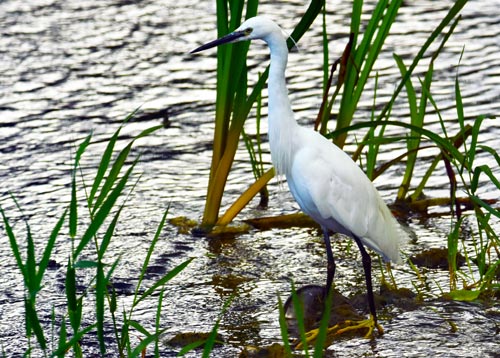‘Little Egret‘.
Extract from a poem by Johno Brett.
“Standing tall and proud at the water’s edge,
Plumage stark white against the salt marsh,
Jet black legs and yellow feet,
With a sharp stabbing beak,
Stands the Little Egret.”
The little egret (Egretta garzetta) is a species of small heron, white in colour with a slender black beak, long black legs and yellow feet. Every day this week, usually between the hours of 4:00pm and 7:00pm, one such bird can be observed fishing in the shallow water of the river Suir, close to Barry’s Bridge, in the centre of Thurles Town.
Research shows that the little egret was once very common in Ireland, but became extinct through a combination of over-hunting in the late medieval period.
In England the inclusion of some 1,000 egrets in a banquet to celebrate the enthronement of George Neville as Archbishop of York at Cawood Castle in 1465, indicates the presence of a sizeable population in northern England at that period in time.
They were also listed in the coronation feast of King Henry VI in 1429 and by the mid-16th century, they had become scarce and nearly extinct.
From the 17th century onwards the plumes of the little egret and its close relatives were in demand for the decorating of hats and became a major craze in Victorian times with the number of egret skins passing through dealers hands reaching into the millions annually, reducing the population of the species to almost extinction and stimulating the establishment of Britain’s Royal Society for the Protection of Birds in 1889.
Sometime in the 1950s, conservation laws were introduced in southern Europe to protect the species and since then their numbers began to increase. By the beginning of the 21st century the breed began expand westward, breeding again in the UK back in the 1960s before arriving in Ireland in more recent years.
Little egrets stalk their prey in shallow water, often observed shuffling their feet in an effort to disturb small fish, or may stand still and simply wait to ambush other available prey which include frogs, crustaceans, molluscs, insects, spiders and worms.
Here in Ireland, the species bred for the first time in 1997 at a site in Co. Cork and the population has expanded rapidly since, aided by climate change, and is now breeding in other Irish counties, since 2010, despite the severe cold winter weather experienced during the years 2010 – 2012.



Leave a Reply